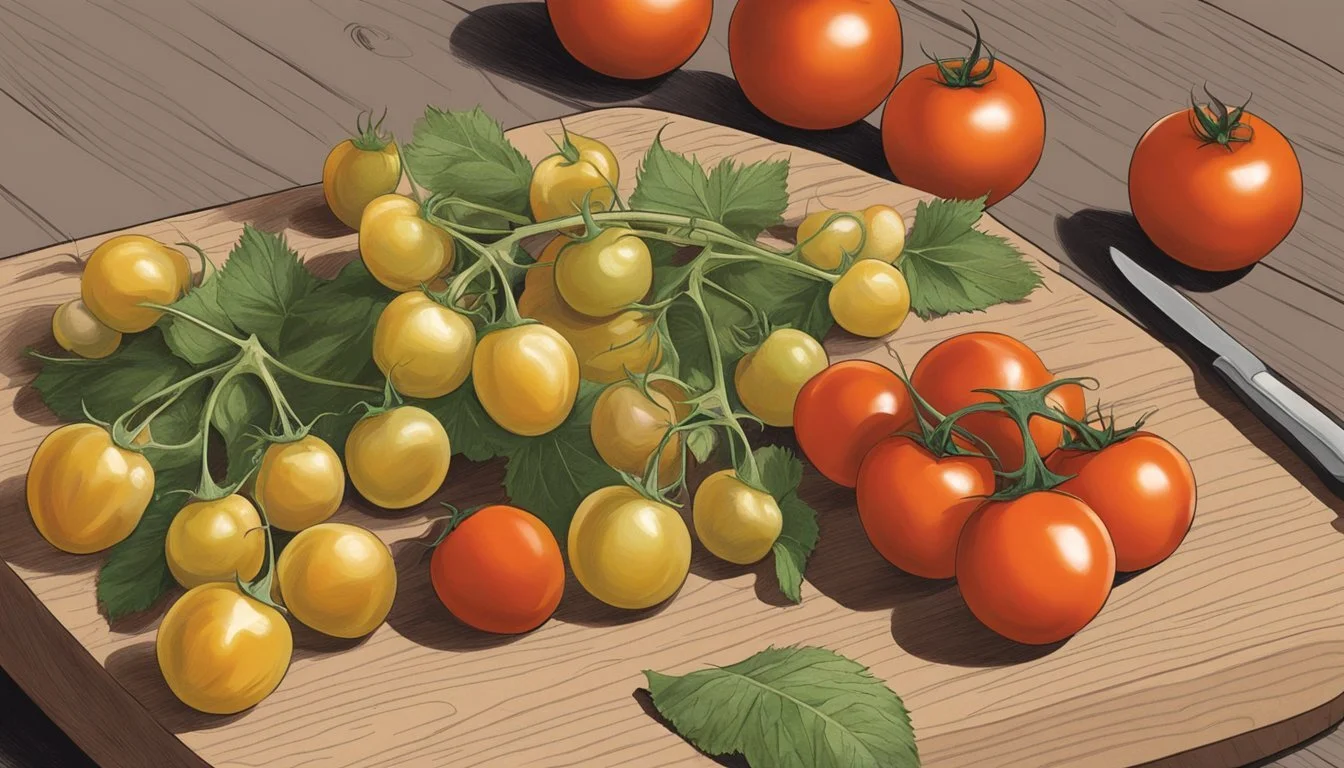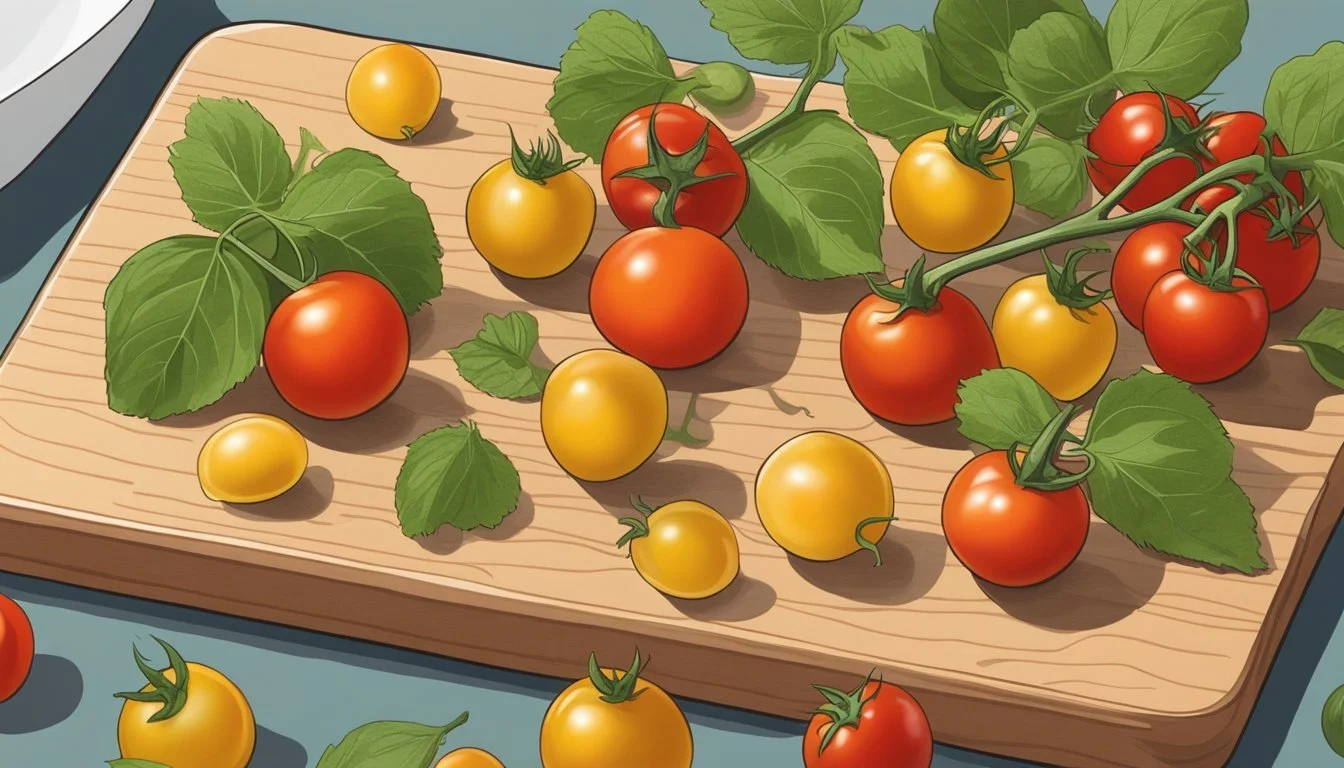How to Substitute Ground Cherries for Cherry Tomatoes
An Easy Swap Guide
Ground cherries, with their unique flavor profile that blends hints of pineapple, vanilla, and tomato, offer an excellent option for culinary enthusiasts looking to add a twist to their dishes. Unlike the commonly known cherry tomatoes, ground cherries come enclosed in a papery husk and exhibit a more complex sweetness, making them an intriguing substitute in recipes where cherry tomatoes are used for their sweet, acidic punch.
In the kitchen, ground cherries can effortlessly enhance a variety of recipes, from salads to salsas, where cherry tomatoes would traditionally play a role. Their versatility is evident as they retain their structural integrity when cooked, which allows them to be incorporated into cooked courses or baked goods. The substitution not only brings a new dimension of taste but also adds a visual appeal with their golden-yellow to orange hue.
When substituting ground cherries for cherry tomatoes, it is important to consider the texture and flavor differences. Although ground cherries can impart a tropical essence to dishes that would be more subdued with cherry tomatoes, their nuanced taste is perfectly compatible with the acidity and sweetness found in tomato-based recipes. This substitution invites an exploration of flavor, encouraging both amateur cooks and professional chefs to experiment with the potential of these small but mighty fruits.
Understanding Ground Cherries
Ground cherries, a small yet impactful fruit, hold versatility both in the kitchen and garden. This section delves into their botanical identity, uses in cooking, when they're available, and their nutritional profile.
Botanical Profile
Ground cherries, scientifically known as Physalis pruinosa, are part of the Nightshade family, which includes tomatoes and tomatillos. They are characterized by their small, round fruit encased in a papery husk, similar to that of a tomatillo. The plant prefers humus-rich, well-draining soil and requires adequate space in a garden due to its sprawling nature.
Culinary Uses
In the culinary world, ground cherries can be a unique substitute for cherry tomatoes, providing a sweet and tangy flavor that enhances both sweet and savory dishes. They can be eaten raw, made into preserves, or used in salads, salsas, and desserts. Their versatility makes them a dynamic ingredient akin to cherry tomatoes.
Seasonality and Availability
Ground cherries are typically available in the late summer to fall. They thrive in environments with full sun exposure and are harvested when their husks turn brown and the fruit inside ripens to a golden-yellow shade. The seasonality of ground cherries is essential to consider when planning to use them as a substitute for cherry tomatoes.
Nutritional Value
Ground cherries are a nutritious addition to any diet, rich in Vitamins, including Vitamin C, Vitamin A, and Vitamin B, as well as other essential Nutrients. Here's a brief breakdown of their nutritional content:
Nutrient Value per 100g Calories 53 Fat 0.7g Carbohydrates 11.2g Fiber 4.9g Sugars 6.7g Protein 1.9g Vitamin C 11% of the DV Vitamin A 14% of the DV
Note: DV = Daily Value
Ground cherries offer a delightful taste experience and nutritional benefits, serving as a suitable replacement for cherry tomatoes in a variety of recipes.
Understanding Cherry Tomatoes
Cherry tomatoes are a staple in culinary use due to their sweet flavor and versatile application in a variety of dishes. They come in several varieties and can enhance both the taste and visual appeal of food.
Varieties of Cherry Tomatoes
Cherry tomatoes come in numerous varieties, including but not limited to:
Sweet Cherry Tomatoes: Known for their sugary taste and round shape, ideal for fresh consumption.
Grape Tomatoes: More elongated than their cherry counterparts, with a firmer texture and slightly less sweetness.
Currant Tomatoes: The smallest type, resembling currants with a burst of intense flavor.
Heirloom Cherry Tomatoes: These offer a wider range of flavors and colors due to their diverse genetic backgrounds.
Flavor Profile
The flavor profile of cherry tomatoes is predominantly sweet, with a balanced blend of tartness and juiciness. This sweetness can vary slightly between varieties, with some boasting a more pronounced sugary taste than others.
Uses in Dishes
Cherry tomatoes can be utilized in a myriad of dishes. Their uses include:
Fresh salads, for a burst of color and sweetness.
Roasted or grilled, to concentrate their flavor and add a caramelized note.
As a garnish, to add visual appeal and a fresh, sweet pop to any dish.
Their size makes them ideal for a convenient, bite-sized addition to appetizers and snacks.
Substituting Ground Cherries for Cherry Tomatoes
When opting for ground cherries as a substitute for cherry tomatoes, one must consider their unique taste and texture. They are not direct substitutes but can bring a delightful twist to dishes traditionally using cherry tomatoes.
Taste Considerations
Ground cherries have a tropical and sweet taste with a hint of tartness, unlike the tangy and juicy flavor of cherry tomatoes. They work best in dishes where a fruity note is complementary. When using ground cherries in salads or pasta dishes, the cook should adjust other ingredients to balance the sweetness.
Texture Adjustments
Textures differ significantly between the two: cherry tomatoes are juicier and firmer, while ground cherries are softer with a more delicate skin. To mimic the bite of cherry tomatoes in sauces, ground cherries should be cooked down slightly less.
Proportion and Measurements
Cherry Tomatoes Ground Cherries 1 cup (halved) 3/4 cup (whole)
This ratio ensures that the ground cherries do not overwhelm the dish, considering their pronounced flavor profile. Therefore, one should use three-quarters cup of ground cherries for every cup of halved cherry tomatoes required.
Best Dishes for Substitution
Ground cherries excel as a tomato substitute in cold dishes such as salads or as a garnish. Their unique taste can also add depth to sweet and savory sauces. However, in heated dishes like pasta, the cook must consider the texture and taste changes that ground cherries will introduce.
Complementary Pairings and Recipes
Ground cherries can successfully substitute for cherry tomatoes in a variety of dishes, offering a distinct sweet and tangy flavor profile. This versatile fruit complements salads, cooked entrées, and can even venture into sweet and savory snacks.
Salad Creations
Ground cherries add an unexpected twist to salads. Their husked berries bursting with juiciness pair exquisitely with leafy greens. An example is a spinach salad where they can replace cherry tomatoes for a hint of sweetness.
Spinach and Ground Cherry Salad:
Fresh spinach leaves
Ground cherries, halved
Feta cheese, crumbled
Red onion, thinly sliced
Balsamic vinaigrette
Cooked Entrées
In cooked dishes, they offer a balance to savory flavors. Ground cherries can be roasted to enhance their natural sweetness, making them ideal for blending into creamy sauces, particularly for pasta dishes.
Roasted Ground Cherry Sauce:
Ground cherries, roasted at 425°F for 45 minutes
Blend until smooth
Season to taste and serve over pasta
Sweet Delights
When it comes to desserts, ground cherries can be baked into pies and tarts for a succulent treat. Their unique flavor makes them a stand-out ingredient in pastry fillings.
Ground Cherry Pie:
Pie crust
Ground cherries mixed with sugar and flour as filling
Bake at 350°F until the crust is golden
Savory Snacks
As appetizers or snacks, they can be transformed into a delicious jam to spread on crackers or bread, complementing cheeses and meats.
Ground Cherry Jam:
Cook ground cherries with sugar and lemon juice
Simmer until thickened
Cool and serve with cheese and crackers
Growing and Harvesting
When cultivating ground cherries and harvesting them for use in recipes, one must consider specific conditions for growth, the timing of the harvest, and proper handling post-harvest to maintain freshness.
Cultivating Ground Cherries
Ground cherries thrive in full sun conditions and require well-draining soil amended with compost. They should be planted with sufficient space to accommodate their growth, typically 18 to 24 inches apart. They prefer humus-rich soil and benefit from an application of balanced fertilizer, such as a 10-10-10 blend.
Sunlight: Full sun (at least 6 hours of direct sunlight daily)
Soil: Amend with a 2-inch layer of compost
Spacing: 18 to 24 inches apart
Fertilizer: 10-10-10 blend, rate of 1 1/2 lbs per 25 square feet
Harvesting Best Practices
Ground cherries are best harvested when their husks turn brown and the fruits fall to the ground. They should be picked up promptly to prevent spoilage. One should check the plants regularly as fruit begins to mature.
Husks: Wait for them to turn brown
Harvest Timing: When fruit falls to the ground
Frequency: Check plants regularly
Post-Harvest Handling
After harvesting, the fruits should be removed from their husks and washed. Ground cherries must be dried thoroughly to prevent mold or spoilage. It is important to handle the delicate fruits with care to avoid bruising.
Cleaning: Wash and remove husks
Drying: Dry thoroughly
Storing Techniques
For short-term storage, ground cherries can be kept at room temperature for several days. For longer preservation, they can be stored in a refrigerator where they can last for several weeks. Ground cherries can also be frozen for later use after proper cleaning and preparation.
Room Temperature: Several days in a breathable container
Refrigeration: Lasts several weeks in a sealed container
Freezing:
Wash and de-husk
Dry completely
Place in airtight, freezer-safe container or bag
Preservation and Processing
When substituting ground cherries for cherry tomatoes in recipes, understanding the differences in preservation and processing techniques is crucial. Ground cherries have a unique taste and texture that requires specific methods to maintain their quality and flavor.
Canning and Preserving
Canning ground cherries is similar to canning cherry tomatoes, but they may take a bit longer due to their firmer texture. Using boiling water bath canning is the recommended method for ground cherries. Here's a quick guide:
Prepare the Ground Cherries:
Wash and remove husks.
Pierce each fruit with a toothpick to prevent bursting.
Fill the Jars:
Place the ground cherries into sterilized jars.
Cover with a hot syrup solution or water, leaving headspace.
Process the Jars:
Place filled jars in a canner with hot water.
Boil for the recommended time (typically 15-20 minutes).
Ground cherries also lend themselves well to chutneys due to their sweet-tart flavor profile, which can be canned for longevity.
Making Ground Cherry Jam
Ground cherry jam is a delightful alternative to traditional jams due to its tropical-like flavor. The jam-making process involves:
Cooking: Simmer ground cherries with sugar and lemon juice until the mixture reaches the setting point.
Canning: Fill into sterilized jars and process in a boiling water bath for secure preservation.
Preparing Ground Cherry Salsa
Ground cherry salsa offers a unique twist on traditional salsa recipes. The process includes:
Combining Ingredients: Mix diced ground cherries with onions, chilies, cilantro, lime juice, and spices.
Canning: If desired, can the salsa for extended shelf life following proper canning guidelines for salsas.
Freezing for Long-Term Use
Freezing is an effortless way to preserve ground cherries:
Preparation:
Sort and wash the fruits, then dry completely.
Freezing:
Spread the ground cherries out on a baking sheet in a single layer.
Freeze until solid and transfer to freezer bags or containers.
This method is particularly useful for later baking endeavors, such as making a ground cherry pie, as the structure of the fruit remains intact when thawed.






